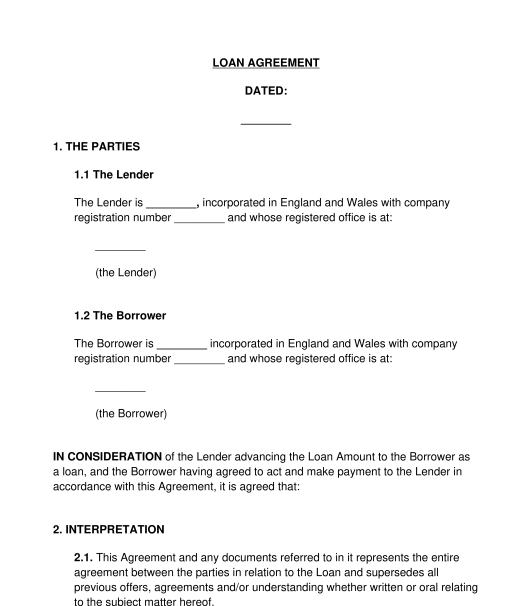 22/09/2025
22/09/2025

Answer a few questions and your document is created automatically.

Your document is ready! You will receive it in Word and PDF formats. You will be able to modify it.




Rating: 4.6 - 142 votes
Fill out the templateA Loan Agreement is a document that governs the relationship between a lender and a borrower throughout the duration of the loan (i.e. until the loan is repaid).
A loan occurs when a person (the lender) agrees to give another person (the borrower) a sum of money for a specific purpose with a promise from the borrower to pay back after an agreed period of time. Usually, the borrower(s) will also have to pay interest on the loan as a form of "rent" for using the money.
The ultimate aim of the Loan Agreement is to ensure the smooth relationship between the lender and borrower and reduce the likelihood of disputes.
The parties to a Loan Agreement are the lender and the borrower. In some cases, a guarantor can also be a party to the agreement.
A lender refers to the party (this could be an individual or corporate entity) that provides money to the borrower with the understanding and expectation that the money will be repaid under the terms of the Loan Agreement.
The borrower is the party (this could also be an individual or corporate entity) that receives money from the lender along with the obligation to repay it according to the terms of the Loan Agreement.
The guarantor is the person or entity who agrees to repay the loan amount in the event that the borrower fails to repay the loan (i.e. defaults on the loan).
Loan Agreements vary in their forms and the parties involved. These include:
No, it is not mandatory to have a Loan Agreement; however, it is advisable to have one, especially where the amount loaned is substantial. Where the loan is a commercial loan, it is very common to have a written Loan Agreement.
A Loan Agreement is a more complex and detailed contract between a lender and a borrower, while a promissory note is a shorter and simpler document where the borrower simply makes a promise to repay the lender at an agreed-upon time.
The Loan Agreement has more comprehensive terms and conditions relating to the loan, as well as the obligations of each party, while the promissory note is just a promise made to the lender that the borrower will repay.
When the Loan Agreement is ready, it should be signed by both parties before any money is transferred. The parties (including any guarantor) should make sure they hold a signed copy. The money to be loaned out should then be advanced on the date set out in the agreement and the terms of repayment will commence in accordance with the terms of the agreement.
As it is common for Loan Agreements to be executed as a deed, the signing of the agreement will need to be witnessed by an independent third party.
A valid witness must be a person who has no personal connection to either of the parties (e.g. a family member) and someone who is over the age of 18 years old.
A deed is a written legal document that is signed in the presence of a witness, which confirms an interest or right and creates a binding obligation on the parties to the written document. Parties to an agreement will usually choose to have the agreement executed as a deed because the presence of witnesses at signing shows that each party understands what they are signing and that they agree with the contents of the agreement.
Under a Loan Agreement, the parties can agree to repay the loan in different ways. They could either choose to repay the whole loan in full on an agreed date or they could agree to the repayment of the loan in instalments with the full amount being paid off at a final date.
The duration of the loan cannot be for an indefinite period; it has to be for a fixed term agreed by the parties.
The term of the loan can be up to as long as 30 years, depending on the type of transaction and amount of money being borrowed (an example of this is in mortgage agreements).
Where the borrower doesn't pay on time, the borrower can make a formal request to the lender asking them to extend the loan repayment date. This is especially beneficial where there have been unforeseen circumstances that have affected the borrower's ability to pay on time.
The borrower can also use a promissory note to make an assurance to the lender that the borrower will repay the loan at a particular date (which is different from the original date in the loan agreement).
In other circumstances, the loan may begin to attract default interest if the borrower fails to pay on time and in extreme situations, take up further legal action against the borrower to force them to pay back the loan (e.g a debt recovery claim in court).
No, it is not mandatory to have an interest rate in a Loan Agreement. This is because it is possible to have an interest-free loan where the borrower is only required to pay back the original amount of money loaned.
There are different kinds of guarantees that can be given in a Loan Agreement. These include:
A Loan Agreement must contain:
Financial Services and Markets Act 2000
Unfair Contract Terms Act 1977
You fill out a form. The document is created before your eyes as you respond to the questions.
At the end, you receive it in Word and PDF formats. You can modify it and reuse it.
A guide to help you: Signing Documents in England and Wales
Loan Agreement - Template, online sample - Word and PDF
Country: United Kingdom